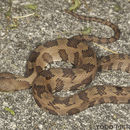en
names in breadcrumbs


Nerodia taxispilota is fairly abundant (so much so that in favorable habitats, 12 or more can be seen in the same area in a small amount of time).
US Federal List: no special status
CITES: no special status
IUCN Red List of Threatened Species: least concern
Nerodia taxispilota has no economic importance (positive or negative) for humans.
Nerodia taxispilota has no economic importance (positive or negative) for humans.
Nerodia taxispilota is piscivorous, preying primarily benthic-feeding fish (mostly minnows, some juvenile catfish), and on frogs. Fetal brown water snakes are nourished by fat yolks deposited within their membranous egg shrouds. Thus female Nerodia taxispilota must acquire lipid reserves well in advance of pregnancies. Gravid females are limited in their hunting strategies (because of their weight) and may rely on scavenging.
Brown water snakes are found in southeastern North America, along the Coastal Plain from Virginia south through the lowlands of the Carolinas, most of Georgia, all of Florida and southern Alabama.
Biogeographic Regions: nearctic (Native )
Nerodia taxispilota is most common in and around clear, quiet waters, on fallen trees, or even bushes suitable for basking. The species has been collected in lakes, rivers, streams, cypress swamps and waterways, canals, drainage ditches, and ponds, especially where overhanging vegetation is present. It is also common around hardwood hammocks of wet materials, sawgrass prairies, bottomland forests, and near tree-bordered margins of brackish tidal marshes.
Terrestrial Biomes: forest
Aquatic Biomes: lakes and ponds; rivers and streams
Average lifespan
Status: captivity: 6.1 years.
Nerodia taxispilota ranges in length from 28 to 69 inches (71.1cm-175.3 cm). The record length is 69.5" (176.6 cm). Females are larger; males do not reach the size of the largest females. Brown Water Snakes are relatively heavy-bodied, and have a large head distinctly wider than the neck. This produces a heart- or diamond-headed appearance (if viewed from above) that makes this species easy to confuse with venomous snakes in the Viperidae family (such as cottonmouths (Agkistrodon piscivorous) and rattlesnakes. Nerodia taxispilota is brown to dark brown in color (indicated by its common name). The most distinctive mark is the separation between its large brown (usually light-edged), squarish vertebral blotches that occur along the lengths of its body. These blotches alternate with a row of similar blotches on each side of the body. Many specimens are exceptionally dark, being a deep chocolate brown in gross appearance and with blotches only a little darker than ground color. The belly of -N. taxispilota- is yellow to brown and boldly marked with brown splotches and black crescents. These markings are often arranged in broken rows along its sides. The dorsal scales of Nerodia taxispilota are strongly keeled in 25-33 midbody rows, and its anal plate is divided. The tail tapers abruptly, and its eyes are high and set forward towards the nose.
This species breeds between late February and early May, with neonates appearing between June and October. Snakes don't have set gestation periods because pregnancy is initiated by the females' ovulation, not by deposition of semen. Viable sperm may be stored for months or even years within the cloaca of inseminated but not-yet-fertilized females. Female Nerodia taxispilota must increase their body's store of lipids by some 50% in order to become pregnant. They give live birth to as many as 60 offspring at once. These offspring range from 7 to 11 inches in length, and their coloring is much brighter than that of their parents.